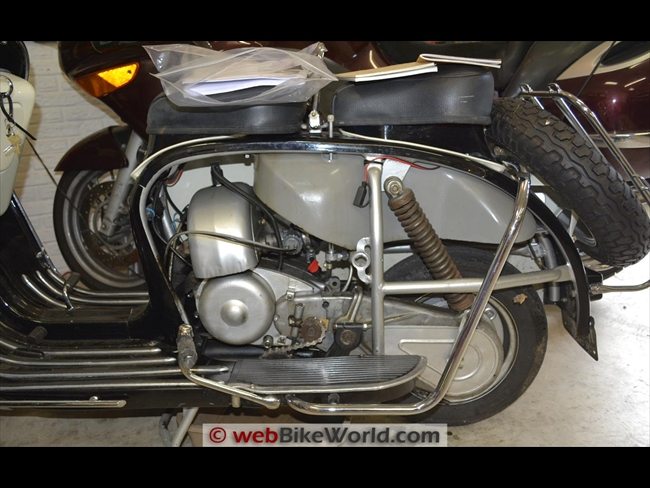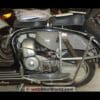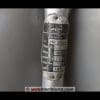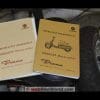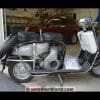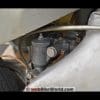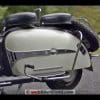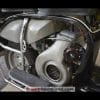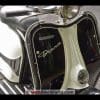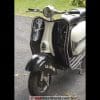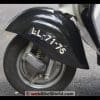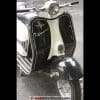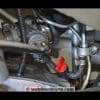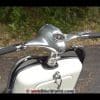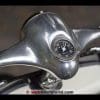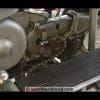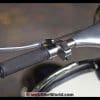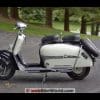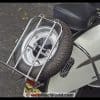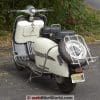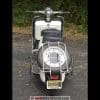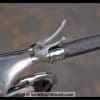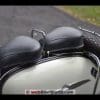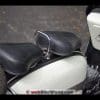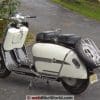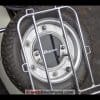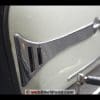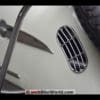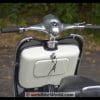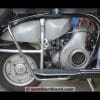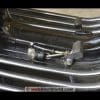1955 Durkopp Diana Scooter: Photos, Video and Info
Here are photos of a friend’s 1955 Durkopp Diana two-stroke scooter.
He brought it over for some work to the fueling system and Chris worked his magic; see the comments about that after the photos.
It now runs like a champ and it has a surprising amount of power.
The Diana is a rare beast, especially this 1955 “MR” model. This one has been restored to excellent condition and is used often. Here’s the history of the Durkopp Diana.
Photos and Video!
Click on any photo below to view or to start the slide show and enjoy!
There is a brief video below also showing the start-up routine for the Durkopp Diana, along with a few comments on some of the recent repairs.
Recent Repairs
When the Diana arrived, it started but was blowing huge amounts of fuel mixture and smoke from the exhaust.
Chris machined a new petcock arrangement, fixed the carburetor and added new fuel lines and an additional shut-off valve.
Electrical work included cleaning and filing the points (remember them?). Then Chris had to determine the location of TDC and find the correct timing marks and then set the timing, which was way off.
The wire between the points and condenser was shorting to ground because of mis-routing and as a result, it was touching the magneto flywheel, so that was repaired. The condenser was also replaced.
The ignition wire from the magneto to the spark plug was repaired and a new spark plug installed. Finally, the sticking throttle grip was fixed.
Condenser
The condenser came from The Moped Junkyard. Chris said that he always received a prompt response to his emails, even though they had no experience with anything as old as this Diana.
The condenser he used was Part # IC 300 (although he also bought the IC 200 just in case).
It was a perfect fit into the cavity (whereas the previous one had a piece of sheet metal stuck along side to keep it tight and provide a ground, since it was smaller in diameter).
The condenser was originally used with a magneto system and it has a threaded connector. It was a simple matter of soldering a small eyelet terminal onto the primary wires.
Spark Plug
The owner’s manual said to use a spark plug with a “14mm diameter with a 1/2″ reach in the 225-240 heat range”, which is a heat range designation that was used eons ago but has long since been dropped.
The plug that was in there was a NGK B6HS, but it was difficult for Chris to determine its heat range.
He called the guys at McHenry Small Engines in Frederick, Maryland and they came up with a listing for a Champion L86C, which is also cross-referenced to the NGK B6HS.
Chris said that the old plug had become fouled enough that the spark was jumping internally with a higher load. “All I know is with the new spark plug, the engine did not miss above a certain engine speed like it was doing before.
Of course, I replaced the ignition wire at the same time, since I found a melted spot covered with electrical tape.
For the ignition wire, I just happened to have one complete, new, Mercedes-Benz solid wire core ignition wire with both ends: one for a distributor cap and the other for the spark plug.
It was a simple matter of cutting it to the correct length, soldering one end onto the magneto, a special connector to the other end and the plug wire end onto it.
I also used some of that split, plastic wire harness covering to protect it from chafing.
Brake Light
The brake light also wasn’t working, although the running light was (see photo in the slide show above).
Chris found the connectors and the switch were corroded, so they were cleaned with a wire brush and razor blade and some di-electric grease to prevent it from happening again.
The spring between the switch and brake lever was too long and too weak to pull the plunger on the switch; Chris said he wondered how it ever worked properly before, but now it’s fixed.
Master Listing of All wBW Motorcycle Product Reviews
Owner Comments and Feedback
See details on submitting comments.
From “D.H.” (November 2014): “That is one beautiful scooter. It has the verve of the Lambretta with a lightness and grace that you just don’t see in a scooter from that era.
If any (Asian?) manufacturer wants to reproduce those lines in a modern 200cc-class 4-stroke ride, I’m right in your target demographic. Thanks for showing all those angles!”
From “B” (November 2014): “One of my uncles had one of these, he got it new in 1955 and was still riding it to work every day 10 years later.
Admittedly as it was stored outside with no cover or protection and no “beauty” work done, just keeping the mechanicals going it did look a bit tatty and clapped out.
The “mods” on their Vespas and Lambrettas used to take the mickey out of him until they did the traffic light drag race and he left almost all of them standing.
He offered to sell it to me but I decided I would bow to peer pressure and bought a Lambretta LD, which died a year later, while the Diana was still going strong.”
Other WebBikeWorld Motorcycle News Posts


